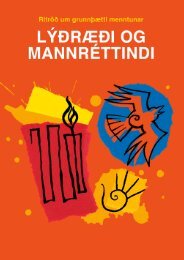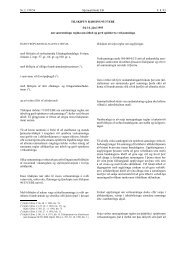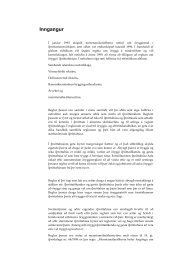Nomination of
Nomination of
Nomination of
Create successful ePaper yourself
Turn your PDF publications into a flip-book with our unique Google optimized e-Paper software.
SURTSEY – NOMINATION FOR THE UNESCO WORLD HERITAGE LIST<br />
The volcanic zones <strong>of</strong> Iceland (Fig. 2.3), are<br />
among the most active on Earth, with an eruption<br />
occurring every three years on average.<br />
Moreover, the country's volcanic activity is<br />
associated with vigorous hydrothermal activity.<br />
Icelandic volcano-tectonics appear to have<br />
been characterised by volcanic systems<br />
throughout the island's geological history. A<br />
volcanic system is a spatial grouping <strong>of</strong> eruption<br />
sites, including feeder dikes and possibly shallow<br />
magma chambers, that usually have in common<br />
certain structural, petrographic and geochemical<br />
characteristics within the bounds <strong>of</strong> the system.<br />
Volcanic production is generally most intense<br />
around the middle <strong>of</strong> each system, where many<br />
have developed a central volcano with the<br />
concomitant production <strong>of</strong> intermediate and acid<br />
rocks. High-temperature hydrothermal activity is<br />
12<br />
Snæfellsnes Zone<br />
Vestmannaeyjar<br />
Surtsey<br />
Western Zone<br />
Eastern Zone<br />
Hekla<br />
Katla<br />
Krafla<br />
50 km<br />
Askja<br />
Northern Zone<br />
Öræfajökull Zone<br />
Tholeiitic<br />
Transitional alkalic<br />
Alkalic<br />
Fig. 2.3. Active volcanic systems in Iceland and on its insular shelf, grouped according to petrological criteria.<br />
The distribution <strong>of</strong> rocks from the Late Pleistocene and Holocene (dark grey) is also shown.<br />
<strong>of</strong>ten connected with the central part <strong>of</strong> each<br />
system, evidenced by steaming vents and<br />
solfataras.<br />
In Iceland and on its insular shelf, about 44<br />
volcanic systems have erupted at least once<br />
during the Holocene and Late Pleistocene (Fig.<br />
2.3), the most active being the Hekla, Katla, Askja<br />
and Krafla systems. The Hekla central volcano<br />
has erupted 19 times during the country's historic<br />
period (i.e. since AD 870), most recently in the<br />
year 2000. The subglacial central volcano <strong>of</strong><br />
Katla has during the same period erupted on<br />
average twice a century, including the most<br />
recent eruption in 1955. The latest eruption<br />
within the Askja caldera occurred in 1961, while<br />
the Krafla volcanic system produced nine small<br />
eruptions from 1975 to 1984 (Ari Trausti<br />
Guðmundsson 2001).



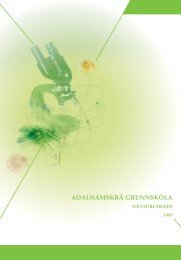
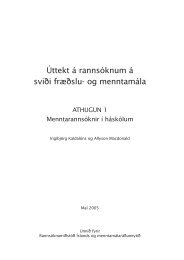

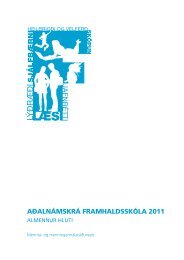
![Aðalnámskrá tónlistarskóla : rytmÃsk tónlist [Eingöngu á rafrænu formi]](https://img.yumpu.com/50843672/1/184x260/aaalnamskra-tanlistarskala-rytma-sk-tanlist-eingangu-a-rafranu-formi.jpg?quality=85)
